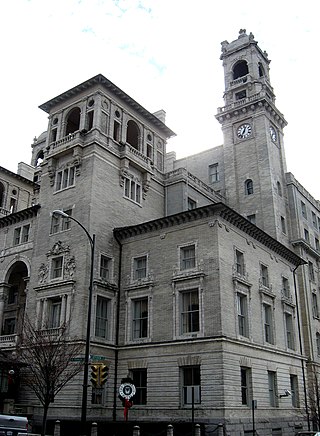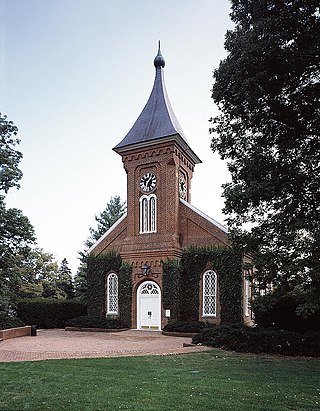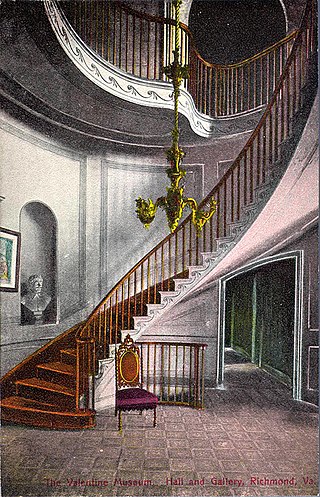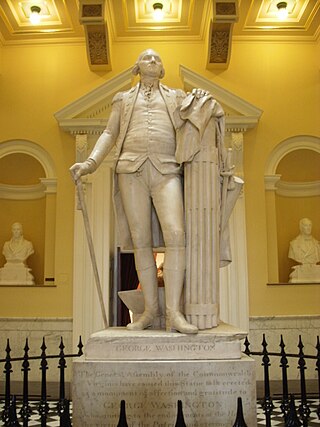
Lee Oscar Lawrie was an American architectural sculptor and a key figure in the American art scene preceding World War II. Over his long career of more than 300 commissions Lawrie's style evolved through Modern Gothic, to Beaux-Arts, Classicism, and, finally, into Moderne or Art Deco.

Moses Jacob Ezekiel, also known as Moses "Ritter von" Ezekiel, was an American sculptor who lived and worked in Rome for the majority of his career. Ezekiel was "the first American-born Jewish artist to receive international acclaim".

Karl Theodore Francis Bitter was an Austrian-born American sculptor best known for his architectural sculpture, memorials and residential work.

Monroe Park is a 7.5 acres (3.0 ha) landscaped park 1 mile (1.6 km) northwest of the Virginia State Capitol Building in Richmond, Virginia. It is named after James Monroe, the fifth president of the United States (1817–1825). The park unofficially demarcates the eastern point of the Fan District and is Richmond's oldest park. It occupies the center of the Virginia Commonwealth University Monroe Park Campus.

The Louisiana State Capitol is the seat of government for the U.S. state of Louisiana and is located in downtown Baton Rouge. The capitol houses the chambers for the Louisiana State Legislature, made up of the House of Representatives and the Senate, as well as the office of the Governor of Louisiana. At 450 feet (137 m) tall and with 34 stories, it is the tallest skyscraper in Baton Rouge, the seventh tallest building in Louisiana, and tallest capitol in the United States. It is located on a 27-acre (110,000 m2) tract, which includes the capitol gardens. The Louisiana State Capitol is often thought of as "Huey Long's monument" due to the influence of the former Governor and U.S. Senator in getting the capitol built. The building's construction was completed in 1931. It was listed on the National Register of Historic Places in 1978 and was designated a National Historic Landmark in 1982.

The Jefferson Hotel is a luxury hotel in Richmond, Virginia, United States, opened in 1895. In 1969, it was listed on the National Register of Historic Places.

University Chapel of Washington and Lee University is a National Historic Landmark in Lexington, Virginia. It was constructed during 1867–68 at the request of Robert E. Lee, who was president of the school, and after whom the university is, in part, named. The Victorian brick architectural design was probably the work of Lee's son, George Washington Custis Lee, with details contributed by Col. Thomas Williamson, an architect and professor of engineering at the neighboring Virginia Military Institute. Upon completion and during Robert E. Lee's lifetime it was known as the College Chapel. Lee was buried beneath the chapel in 1870.

The Valentine is a museum in Richmond, Virginia dedicated to collecting, preserving and interpreting Richmond's history. Founded by Mann S. Valentine II 1898, it was the first museum in Richmond.

Henry Merwin Shrady was an American sculptor, best known for the Ulysses S. Grant Memorial on the west front of the United States Capitol in Washington, D.C.

Attilio Piccirilli was an American sculptor. Born in Massa, Italy, he was educated at the Accademia di San Luca of Rome.
Historic Artists' Homes and Studios program is a network of about 30 artists' homes and studios in the United States. The network of house museums is a program of the National Trust for Historic Preservation.

George Julian Zolnay was a Romanian, Hungarian, and American sculptor called the "sculptor of the Confederacy".

George Washington is a statue by the French sculptor Jean-Antoine Houdon from the late 18th century. Based on a life mask and other measurements of George Washington taken by Houdon, it is considered one of the most accurate depictions of the subject. The original sculpture is located in the rotunda of the Virginia State Capitol in Richmond, Virginia, and it has been copied extensively, with one copy standing in the United States Capitol Rotunda.

Andrew Jackson is a bronze equestrian statue by Clark Mills mounted on a white marble base in the center of Lafayette Square within President's Park in Washington, D.C., just to the north of the White House. Jackson is depicted dressed in military uniform, raising his hat with his right hand, while controlling the reins with his left hand as his horse rises on its rear legs.
Robert E. Lee is a bronze sculpture commemorating the general of the same name by Edward Virginius Valentine, formerly installed in the crypt of the United States Capitol as part of the National Statuary Hall Collection. The statue was given by the commonwealth of Virginia in 1909. On December 21, 2020, the sculpture was removed from the grounds of the United States Capitol and relocated to the Virginia Museum of History & Culture.

The Jefferson Davis Memorial was a memorial for Jefferson Davis (1808–1889), president of the Confederate States of America from 1861 to 1865, installed along Richmond, Virginia's Monument Avenue, in the United States. The monument was unveiled on Davis' birthday, June 3, 1907, a day celebrated in Virginia and many other Southern states as Confederate Memorial Day. It consisted of a bronze statue of Davis by Richmond sculptor Edward Valentine surrounded by a colonnade of 13 columns represented the Southern states, and a tall Doric column topped by a bronze statue, also by Valentine, representing Southern womanhood.

The statue of the Confederate States of America cavalry general Williams Carter Wickham by Edward Virginius Valentine was installed in Richmond, Virginia's Monroe Park in 1891, near Virginia Commonwealth University's main campus. It was toppled in June 2020 during the George Floyd protests.
















